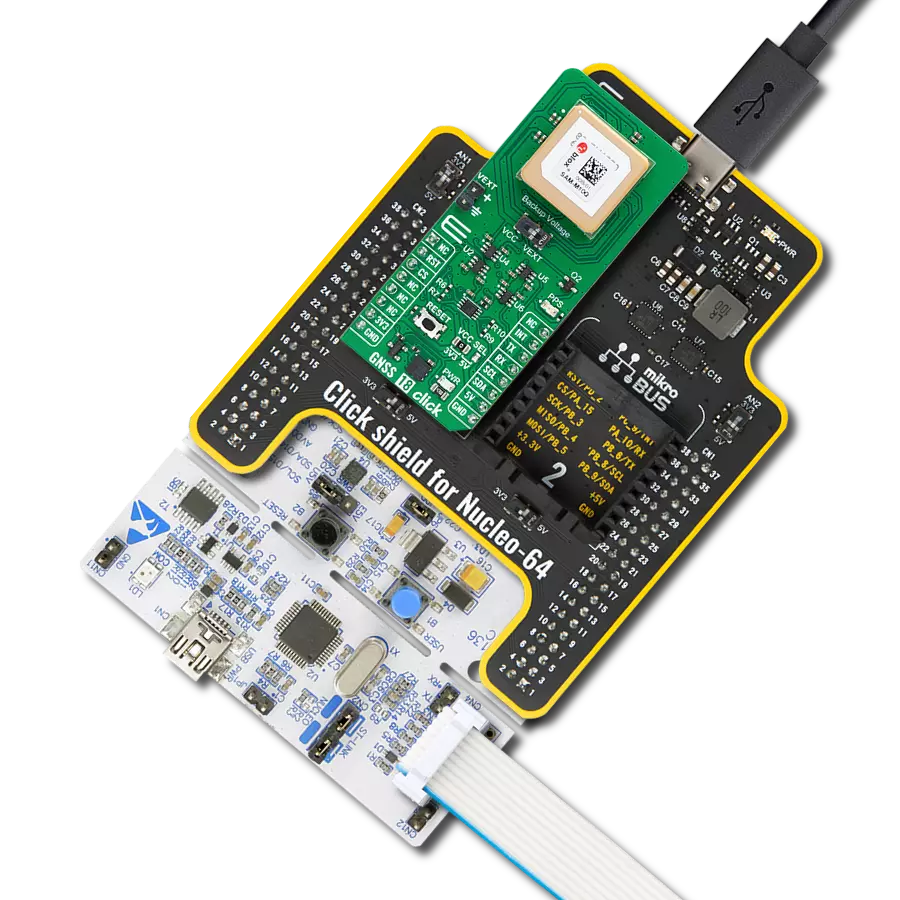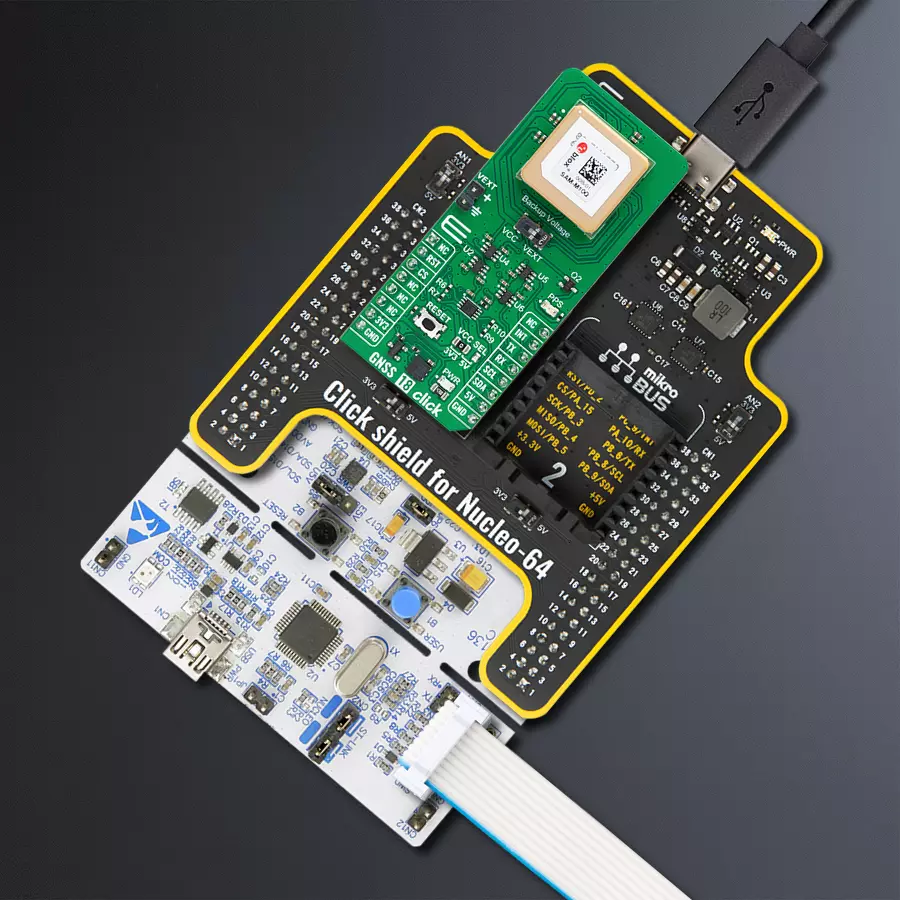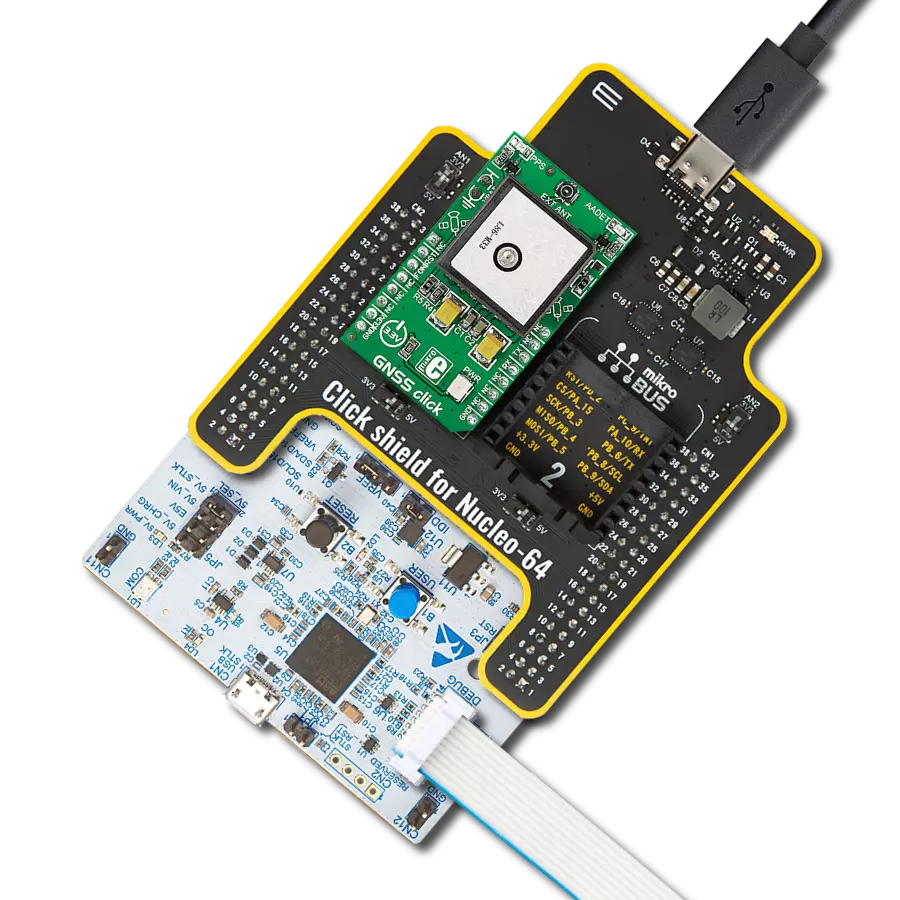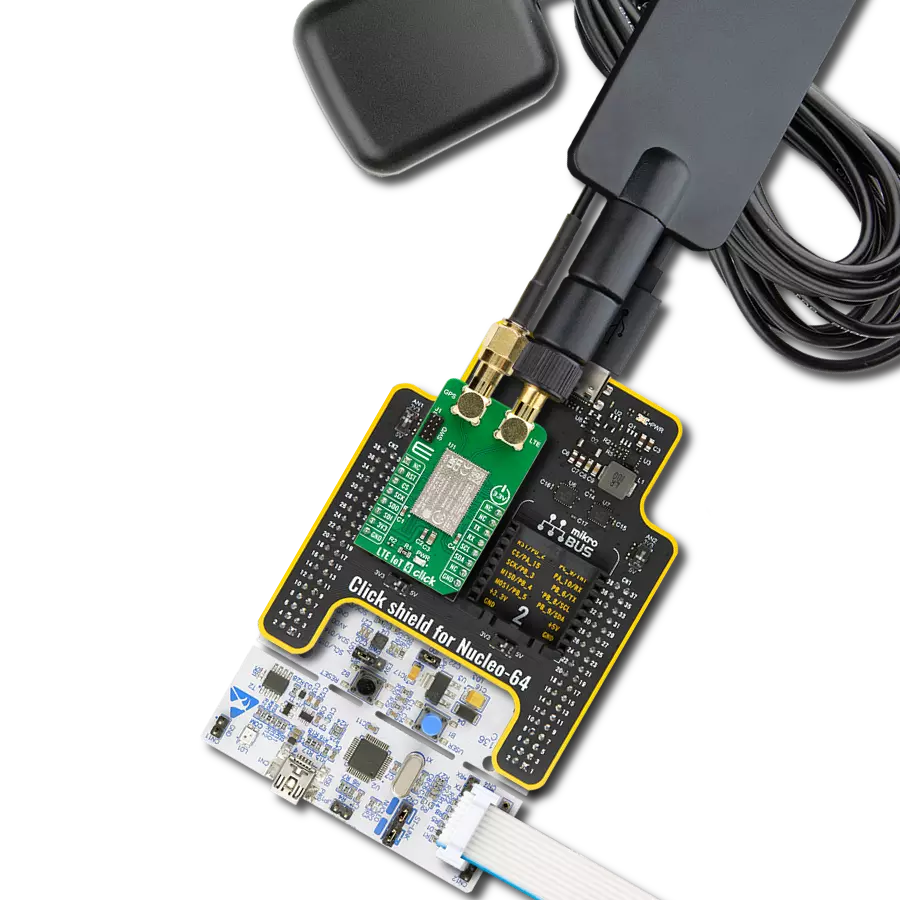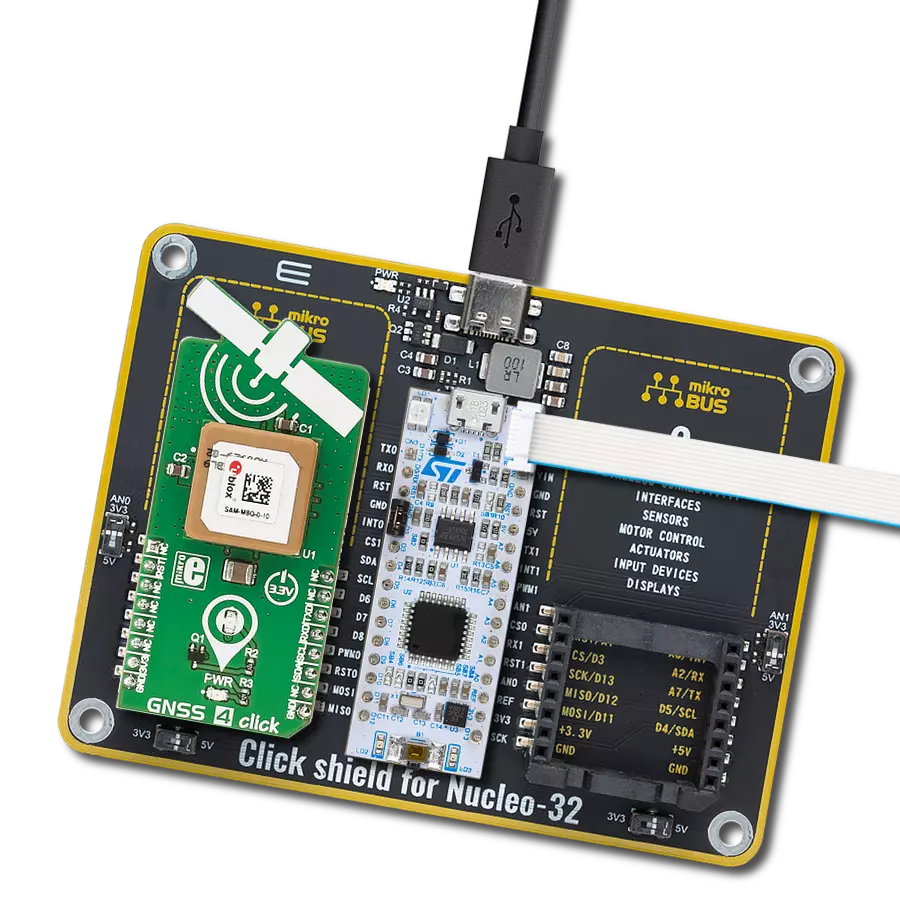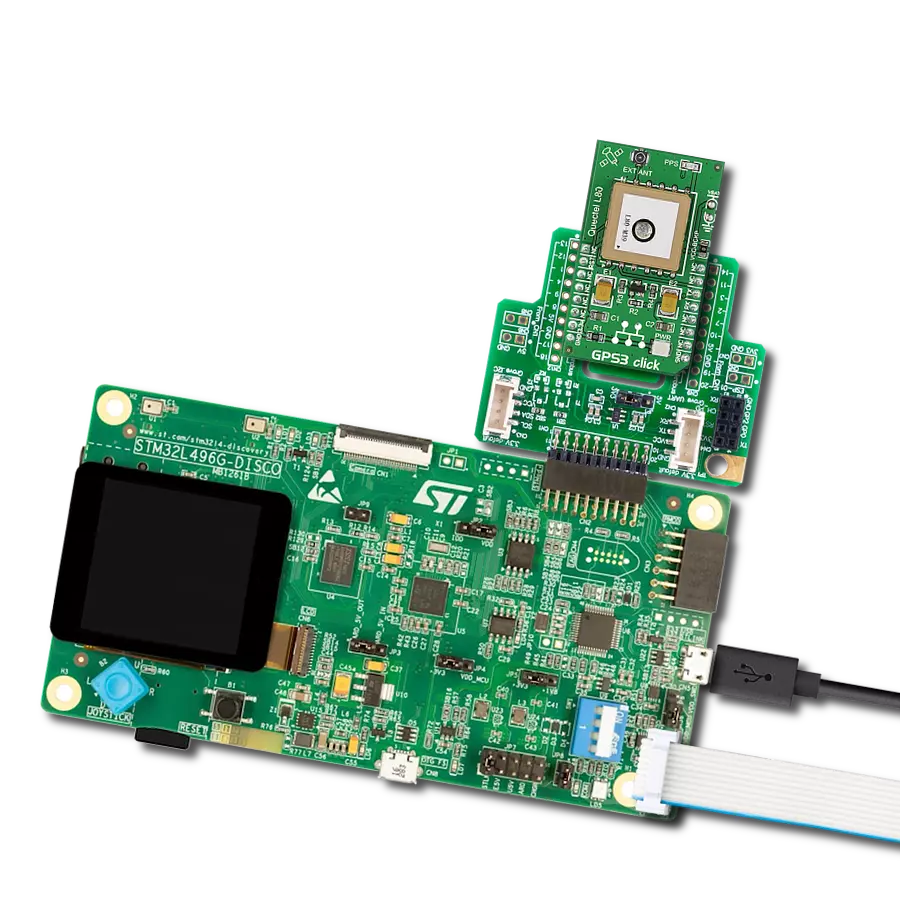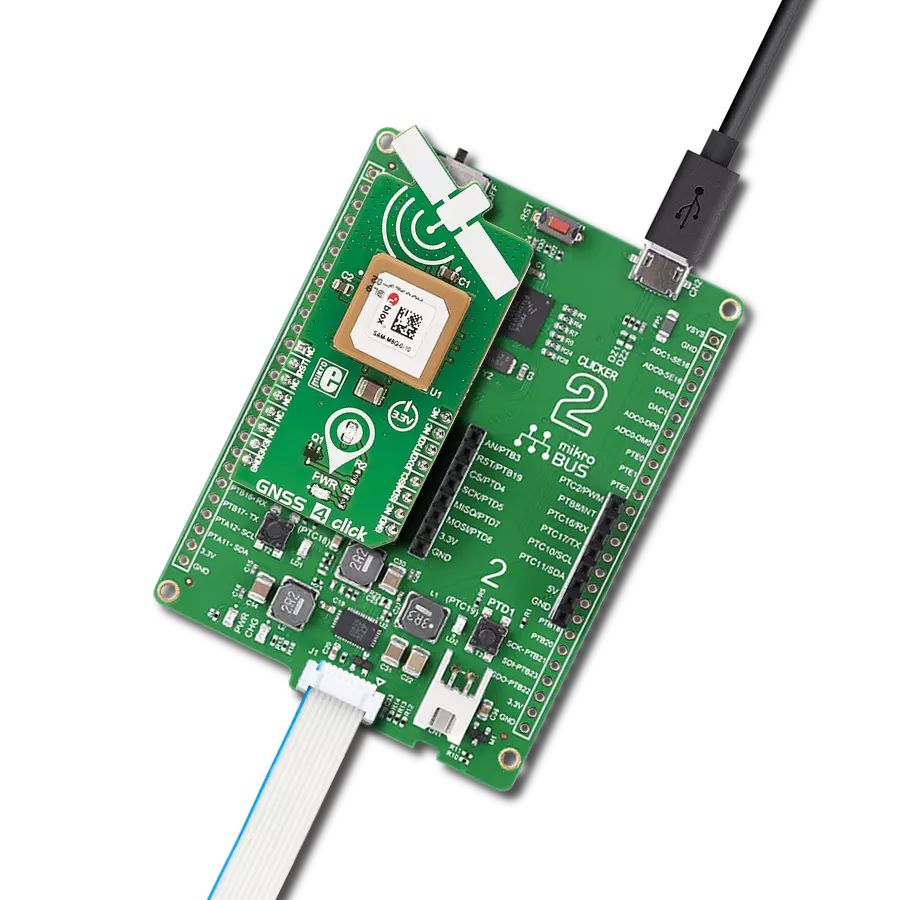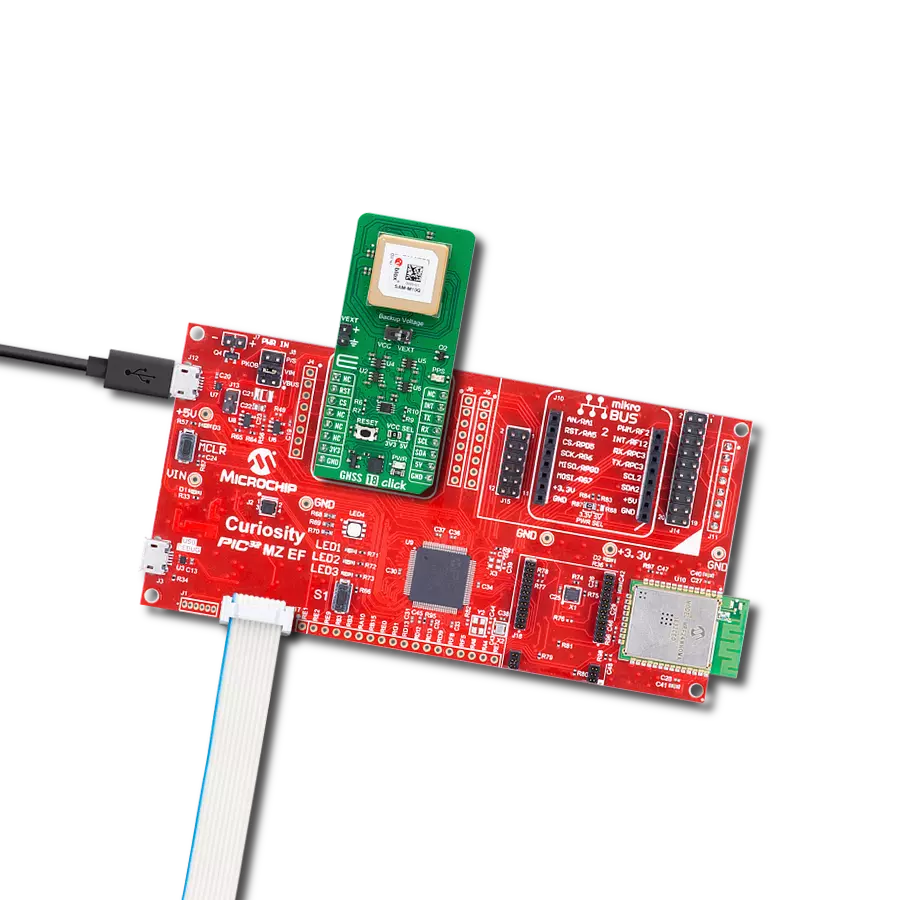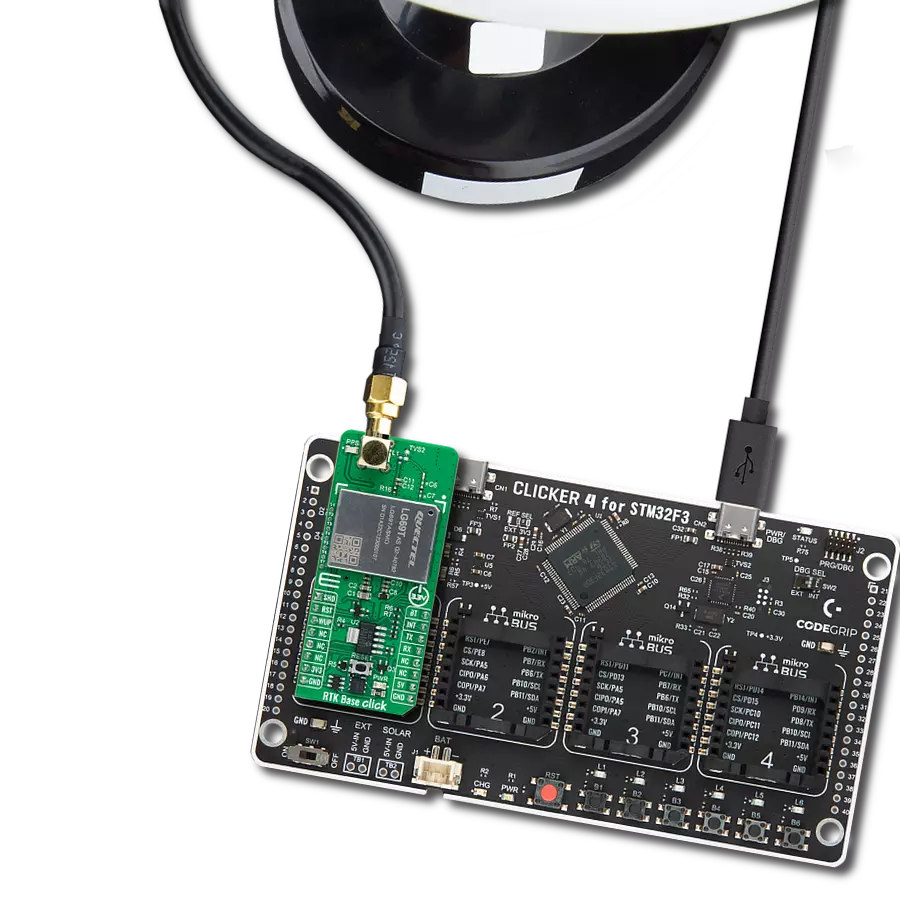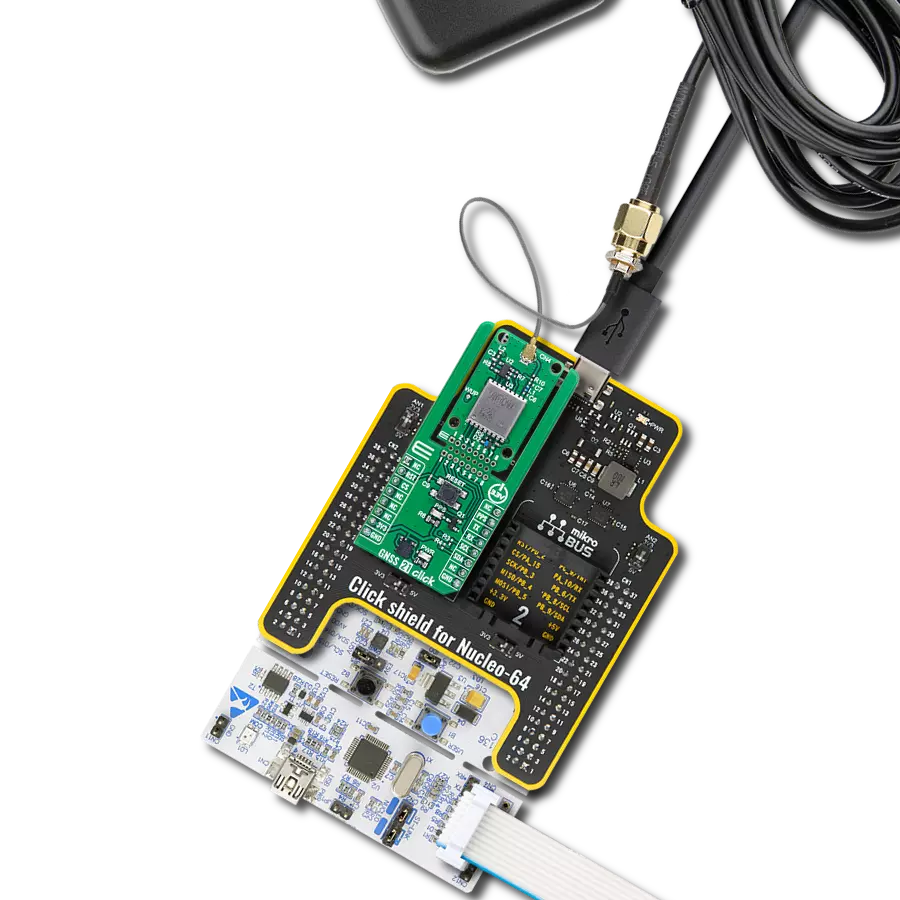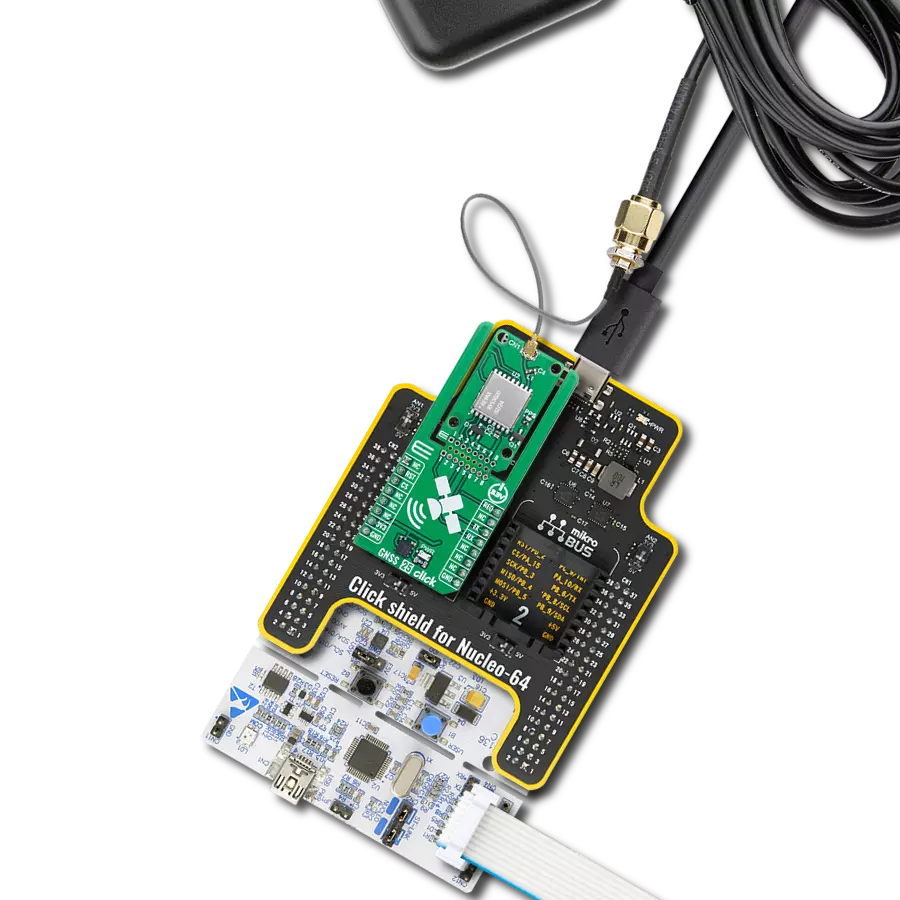Precisely locate and monitor the movement of equipment, vehicles, or personnel in real-time for accurate location awareness
A
A
Hardware Overview
How does it work?
GNSS 18 Click is based on the SAM-M10Q, a high-precision GNSS antenna module from u-blox. This module uses the u-blox M10 standard precision GNSS platform, known for its outstanding sensitivity and rapid acquisition time across all L1 GNSS signals. The M10 platform supports the simultaneous reception of signals from four GNSS systems. By default, the SAM-M10Q-00B is configured to concurrently receive signals from GPS, Galileo, GLONASS, and BeiDou B1C, with additional support for QZSS and SBAS. Its single RF front-end architecture allows it to capture multiple GNSS constellations simultaneously, providing flexibility to configure for a subset of GNSS constellations to optimize power consumption. Accessing many visible satellites ensures the receiver can select the strongest signals, maximizing position availability even in challenging environments like deep urban canyons. u-blox Super-S (Super-Signal) technology enhances the RF sensitivity of the SAM-M10Q module, significantly improving dynamic position accuracy in non-line-of-sight scenarios. Assuming an Airborne 4g platform, the module's operational limits include an altitude capability of up to 80,000 meters and a velocity of up to 500 meters per
second. With a remarkably low power consumption of just 37mW in continuous tracking mode while concurrently tracking four GNSS, this module ensures excellent power efficiency, making it ideal for battery-operated devices like asset trackers without sacrificing GNSS performance. The SAM-M10Q module has an integrated GNSS patch antenna, ensuring optimal signal reception. An internal SAW filter and a low-noise amplifier (LNA) further enhance the RF signal, which provides superior out-band jamming immunity, making it highly effective even when a cellular modem is nearby. The SAM-M10Q is equipped with features to detect jamming and spoofing attempts, promptly reporting these events to the host system to enable an appropriate response. Communication between the SAM-M10Q and the host MCU is made through a UART interface using the standard UART RX and TX pins. The module communicates at 115200bps by default, allowing efficient data exchange. Also, for developers looking to build their software from scratch, the module also includes I2C communication capabilities, operational only in Slave mode, with clock frequencies up to 400kHz. Besides interface pins, this Click board™ also incorporates a reset pin (RST) and RESET button
for direct module resetting and an external interrupt signal (INT) that can be programmed for various functions, such as waking up the module. It also features an orange PPS LED indicator that signals the pulse per second, adjustable to different conditions. This SAM-M10Q also has the possibility of a backup 3V supply from an external source connected to VEXT pins. The main and backup power source can be selected via the Backup Voltage switch, which can be placed in the desired position: VCC for the internal and VEXT for an external power source. This Click board™ can operate with both 3.3V and 5V logic voltage levels selected via the VCC SEL jumper. Given that the SAM-M10Q module operates at 3.3V, a pack of logic-level translators, PCA9306 and several SN74LVC1T45s, are also used for proper operation and an accurate signal-level translation. This way, both 3.3V and 5V capable MCUs can use the communication lines properly. Also, this Click board™ comes equipped with a library containing easy-to-use functions and an example code that can be used as a reference for further development.
Features overview
Development board
Nucleo-64 with STM32F030R8 MCU offers a cost-effective and adaptable platform for developers to explore new ideas and prototype their designs. This board harnesses the versatility of the STM32 microcontroller, enabling users to select the optimal balance of performance and power consumption for their projects. It accommodates the STM32 microcontroller in the LQFP64 package and includes essential components such as a user LED, which doubles as an ARDUINO® signal, alongside user and reset push-buttons, and a 32.768kHz crystal oscillator for precise timing operations. Designed with expansion and flexibility in mind, the Nucleo-64 board features an ARDUINO® Uno V3 expansion connector and ST morpho extension pin
headers, granting complete access to the STM32's I/Os for comprehensive project integration. Power supply options are adaptable, supporting ST-LINK USB VBUS or external power sources, ensuring adaptability in various development environments. The board also has an on-board ST-LINK debugger/programmer with USB re-enumeration capability, simplifying the programming and debugging process. Moreover, the board is designed to simplify advanced development with its external SMPS for efficient Vcore logic supply, support for USB Device full speed or USB SNK/UFP full speed, and built-in cryptographic features, enhancing both the power efficiency and security of projects. Additional connectivity is
provided through dedicated connectors for external SMPS experimentation, a USB connector for the ST-LINK, and a MIPI® debug connector, expanding the possibilities for hardware interfacing and experimentation. Developers will find extensive support through comprehensive free software libraries and examples, courtesy of the STM32Cube MCU Package. This, combined with compatibility with a wide array of Integrated Development Environments (IDEs), including IAR Embedded Workbench®, MDK-ARM, and STM32CubeIDE, ensures a smooth and efficient development experience, allowing users to fully leverage the capabilities of the Nucleo-64 board in their projects.
Microcontroller Overview
MCU Card / MCU
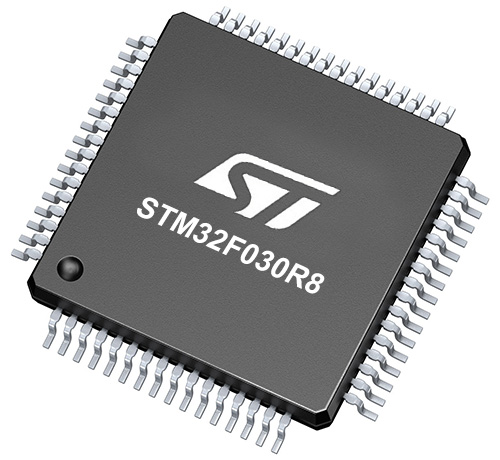
Architecture
ARM Cortex-M0
MCU Memory (KB)
64
Silicon Vendor
STMicroelectronics
Pin count
64
RAM (Bytes)
8192
You complete me!
Accessories
Click Shield for Nucleo-64 comes equipped with two proprietary mikroBUS™ sockets, allowing all the Click board™ devices to be interfaced with the STM32 Nucleo-64 board with no effort. This way, Mikroe allows its users to add any functionality from our ever-growing range of Click boards™, such as WiFi, GSM, GPS, Bluetooth, ZigBee, environmental sensors, LEDs, speech recognition, motor control, movement sensors, and many more. More than 1537 Click boards™, which can be stacked and integrated, are at your disposal. The STM32 Nucleo-64 boards are based on the microcontrollers in 64-pin packages, a 32-bit MCU with an ARM Cortex M4 processor operating at 84MHz, 512Kb Flash, and 96KB SRAM, divided into two regions where the top section represents the ST-Link/V2 debugger and programmer while the bottom section of the board is an actual development board. These boards are controlled and powered conveniently through a USB connection to program and efficiently debug the Nucleo-64 board out of the box, with an additional USB cable connected to the USB mini port on the board. Most of the STM32 microcontroller pins are brought to the IO pins on the left and right edge of the board, which are then connected to two existing mikroBUS™ sockets. This Click Shield also has several switches that perform functions such as selecting the logic levels of analog signals on mikroBUS™ sockets and selecting logic voltage levels of the mikroBUS™ sockets themselves. Besides, the user is offered the possibility of using any Click board™ with the help of existing bidirectional level-shifting voltage translators, regardless of whether the Click board™ operates at a 3.3V or 5V logic voltage level. Once you connect the STM32 Nucleo-64 board with our Click Shield for Nucleo-64, you can access hundreds of Click boards™, working with 3.3V or 5V logic voltage levels.
Used MCU Pins
mikroBUS™ mapper
Take a closer look
Click board™ Schematic

Step by step
Project assembly
Track your results in real time
Application Output
1. Application Output - In Debug mode, the 'Application Output' window enables real-time data monitoring, offering direct insight into execution results. Ensure proper data display by configuring the environment correctly using the provided tutorial.

2. UART Terminal - Use the UART Terminal to monitor data transmission via a USB to UART converter, allowing direct communication between the Click board™ and your development system. Configure the baud rate and other serial settings according to your project's requirements to ensure proper functionality. For step-by-step setup instructions, refer to the provided tutorial.

3. Plot Output - The Plot feature offers a powerful way to visualize real-time sensor data, enabling trend analysis, debugging, and comparison of multiple data points. To set it up correctly, follow the provided tutorial, which includes a step-by-step example of using the Plot feature to display Click board™ readings. To use the Plot feature in your code, use the function: plot(*insert_graph_name*, variable_name);. This is a general format, and it is up to the user to replace 'insert_graph_name' with the actual graph name and 'variable_name' with the parameter to be displayed.

Software Support
Library Description
This library contains API for GNSS 18 Click driver.
Key functions:
gnss18_generic_read- This function reads a desired number of data bytes from the module.gnss18_reset_device- This function resets the device by toggling the RST pin.gnss18_parse_gpgga- This function parses the GPGGA data from the read response buffer.
Open Source
Code example
The complete application code and a ready-to-use project are available through the NECTO Studio Package Manager for direct installation in the NECTO Studio. The application code can also be found on the MIKROE GitHub account.
/*!
* @file main.c
* @brief GNSS 18 Click example
*
* # Description
* This example demonstrates the use of GNSS 18 Click by reading and displaying
* the GNSS coordinates.
*
* The demo application is composed of two sections :
*
* ## Application Init
* Initializes the driver and resets the Click board.
*
* ## Application Task
* Reads the received data, parses the GPGGA info from it, and once it receives the position fix
* it will start displaying the coordinates on the USB UART.
*
* ## Additional Function
* - static void gnss18_clear_app_buf ( void )
* - static err_t gnss18_process ( gnss18_t *ctx )
* - static void gnss18_parser_application ( uint8_t *rsp )
*
* @author Stefan Ilic
*
*/
#include "board.h"
#include "log.h"
#include "gnss18.h"
#define PROCESS_BUFFER_SIZE 300
static gnss18_t gnss18;
static log_t logger;
static uint8_t app_buf[ PROCESS_BUFFER_SIZE ] = { 0 };
static int32_t app_buf_len = 0;
/**
* @brief GNSS 18 clearing application buffer.
* @details This function clears memory of application buffer and reset its length and counter.
* @return None.
* @note None.
*/
static void gnss18_clear_app_buf ( void );
/**
* @brief GNSS 18 data reading function.
* @details This function reads data from device and concatenates data to application buffer.
* @param[in] ctx : Click context object.
* See #gnss18_t object definition for detailed explanation.
* @return @li @c 0 - Read some data.
* @li @c -1 - Nothing is read or Application buffer overflow.
* See #err_t definition for detailed explanation.
* @note None.
*/
static err_t gnss18_process ( gnss18_t *ctx );
/**
* @brief GNSS 18 parser application.
* @param[in] rsp Response buffer.
* @details This function logs GNSS data on the USB UART.
* @return None.
* @note None.
*/
static void gnss18_parser_application ( uint8_t *rsp );
void application_init ( void )
{
log_cfg_t log_cfg; /**< Logger config object. */
gnss18_cfg_t gnss18_cfg; /**< Click config object. */
/**
* Logger initialization.
* Default baud rate: 115200
* Default log level: LOG_LEVEL_DEBUG
* @note If USB_UART_RX and USB_UART_TX
* are defined as HAL_PIN_NC, you will
* need to define them manually for log to work.
* See @b LOG_MAP_USB_UART macro definition for detailed explanation.
*/
LOG_MAP_USB_UART( log_cfg );
log_init( &logger, &log_cfg );
log_info( &logger, " Application Init " );
// Click initialization.
gnss18_cfg_setup( &gnss18_cfg );
GNSS18_MAP_MIKROBUS( gnss18_cfg, MIKROBUS_1 );
err_t init_flag = gnss18_init( &gnss18, &gnss18_cfg );
if ( ( UART_ERROR == init_flag ) || ( I2C_MASTER_ERROR == init_flag ) )
{
log_error( &logger, " Communication init." );
for ( ; ; );
}
log_info( &logger, " Application Task " );
}
void application_task ( void )
{
if ( GNSS18_OK == gnss18_process( &gnss18 ) )
{
if ( PROCESS_BUFFER_SIZE == app_buf_len )
{
gnss18_parser_application( app_buf );
}
}
}
int main ( void )
{
/* Do not remove this line or clock might not be set correctly. */
#ifdef PREINIT_SUPPORTED
preinit();
#endif
application_init( );
for ( ; ; )
{
application_task( );
}
return 0;
}
static void gnss18_clear_app_buf ( void )
{
memset( app_buf, 0, app_buf_len );
app_buf_len = 0;
}
static err_t gnss18_process ( gnss18_t *ctx )
{
int32_t rx_size = 0;
uint8_t rx_buf[ PROCESS_BUFFER_SIZE ] = { 0 };
if ( GNSS18_DRV_SEL_UART == ctx->drv_sel )
{
rx_size = gnss18_generic_read( ctx, rx_buf, PROCESS_BUFFER_SIZE );
}
else
{
if ( GNSS18_OK == gnss18_generic_read( ctx, rx_buf, 1 ) )
{
if ( GNSS18_DUMMY != rx_buf[ 0 ] )
{
rx_size = 1;
}
}
}
if ( rx_size > 0 )
{
int32_t buf_cnt = app_buf_len;
if ( ( ( app_buf_len + rx_size ) > PROCESS_BUFFER_SIZE ) && ( app_buf_len > 0 ) )
{
buf_cnt = PROCESS_BUFFER_SIZE - ( ( app_buf_len + rx_size ) - PROCESS_BUFFER_SIZE );
memmove ( app_buf, &app_buf[ PROCESS_BUFFER_SIZE - buf_cnt ], buf_cnt );
}
for ( int32_t rx_cnt = 0; rx_cnt < rx_size; rx_cnt++ )
{
if ( rx_buf[ rx_cnt ] )
{
app_buf[ buf_cnt++ ] = rx_buf[ rx_cnt ];
if ( app_buf_len < PROCESS_BUFFER_SIZE )
{
app_buf_len++;
}
}
}
return GNSS18_OK;
}
return GNSS18_ERROR;
}
static void gnss18_parser_application ( uint8_t *rsp )
{
uint8_t element_buf[ 100 ] = { 0 };
if ( GNSS18_OK == gnss18_parse_gpgga( rsp, GNSS18_GPGGA_LATITUDE, element_buf ) )
{
static uint8_t wait_for_fix_cnt = 0;
if ( ( strlen( element_buf ) > 0 ) )
{
log_printf( &logger, "\r\n Latitude: %.2s degrees, %s minutes \r\n", element_buf, &element_buf[ 2 ] );
gnss18_parse_gpgga( rsp, GNSS18_GPGGA_LONGITUDE, element_buf );
log_printf( &logger, " Longitude: %.3s degrees, %s minutes \r\n", element_buf, &element_buf[ 3 ] );
memset( element_buf, 0, sizeof( element_buf ) );
gnss18_parse_gpgga( rsp, GNSS18_GPGGA_ALTITUDE, element_buf );
log_printf( &logger, " Altitude: %s m \r\n", element_buf );
wait_for_fix_cnt = 0;
}
else
{
if ( wait_for_fix_cnt % 5 == 0 )
{
log_printf( &logger, " Waiting for the position fix...\r\n\n" );
wait_for_fix_cnt = 0;
}
wait_for_fix_cnt++;
}
gnss18_clear_app_buf( );
}
}
// ------------------------------------------------------------------------ END
Additional Support
Resources
Category:GPS/GNSS
